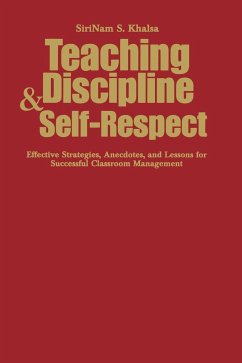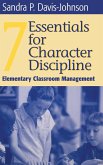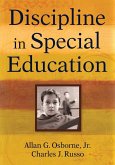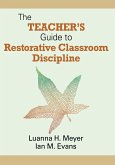Sirinam S. Khalsa
Teaching Discipline & Self-Respect
Effective Strategies, Anecdotes, and Lessons for Successful Classroom Management
Schade – dieser Artikel ist leider ausverkauft. Sobald wir wissen, ob und wann der Artikel wieder verfügbar ist, informieren wir Sie an dieser Stelle.
Sirinam S. Khalsa
Teaching Discipline & Self-Respect
Effective Strategies, Anecdotes, and Lessons for Successful Classroom Management
- Gebundenes Buch
- Merkliste
- Auf die Merkliste
- Bewerten Bewerten
- Teilen
- Produkt teilen
- Produkterinnerung
- Produkterinnerung
Used successfully in culturally, economically, and academically diverse classrooms, these strategies and activities focus on developing students' self-esteem, self-image, and self-responsibility.
Andere Kunden interessierten sich auch für
![Seven Essentials for Character Discipline Seven Essentials for Character Discipline]() Sandra P. Davis-JohnsonSeven Essentials for Character Discipline61,99 €
Sandra P. Davis-JohnsonSeven Essentials for Character Discipline61,99 €![Discipline in Special Education Discipline in Special Education]() Jr. Allan G. OsborneDiscipline in Special Education39,99 €
Jr. Allan G. OsborneDiscipline in Special Education39,99 €![Teaching as a Professional Discipline Teaching as a Professional Discipline]() Geoffrey SquiresTeaching as a Professional Discipline302,99 €
Geoffrey SquiresTeaching as a Professional Discipline302,99 €![Respect of International Humanitarian Law Respect of International Humanitarian Law]() Major Jatto psc (Dr. LivinusRespect of International Humanitarian Law33,99 €
Major Jatto psc (Dr. LivinusRespect of International Humanitarian Law33,99 €![The Teacher's Guide to Restorative Classroom Discipline The Teacher's Guide to Restorative Classroom Discipline]() Luanna H. MeyerThe Teacher's Guide to Restorative Classroom Discipline40,99 €
Luanna H. MeyerThe Teacher's Guide to Restorative Classroom Discipline40,99 €![Working with Boys Working with Boys]() Andrew HamptonWorking with Boys174,99 €
Andrew HamptonWorking with Boys174,99 €![Reclaiming Discipline for Education Reclaiming Discipline for Education]() James MacallisterReclaiming Discipline for Education227,99 €
James MacallisterReclaiming Discipline for Education227,99 €-
-
-
Used successfully in culturally, economically, and academically diverse classrooms, these strategies and activities focus on developing students' self-esteem, self-image, and self-responsibility.
Produktdetails
- Produktdetails
- Verlag: Corwin
- Seitenzahl: 202
- Erscheinungstermin: 15. Februar 2007
- Englisch
- Abmessung: 260mm x 183mm x 16mm
- Gewicht: 585g
- ISBN-13: 9781412915472
- ISBN-10: 1412915473
- Artikelnr.: 20985080
- Herstellerkennzeichnung
- Libri GmbH
- Europaallee 1
- 36244 Bad Hersfeld
- gpsr@libri.de
- Verlag: Corwin
- Seitenzahl: 202
- Erscheinungstermin: 15. Februar 2007
- Englisch
- Abmessung: 260mm x 183mm x 16mm
- Gewicht: 585g
- ISBN-13: 9781412915472
- ISBN-10: 1412915473
- Artikelnr.: 20985080
- Herstellerkennzeichnung
- Libri GmbH
- Europaallee 1
- 36244 Bad Hersfeld
- gpsr@libri.de
Foreword by Jeffrey R. Ryan
Acknowledgments
About the Author
Introduction: About This Book
The Boatman and the Passenger
What Is Teaching Discipline and Self-Respect?
Outcomes of Teaching Discipline and Self-Respect
Chapter Organization
1. Building Cooperation and a Community of Learners
The Heart of an Eagle
Rapport: The Power of Relationships
Outcomes of Establishing Rapport
How to Develop Rapport
Techniques for Creating Dialogue
Strategies for Creating Cooperation
Building a Community of Learners
2. Creating Classroom Procedures and Routines
Changing Behavior Cycles
Discipline Versus Punishment
Alternatives to Punishment
Classroom Procedures and Routines
Teaching Classroom Procedures and Routines
Steps for Teaching Procedures and Routines
Thinking Signs
Follow-Up Feedback
3. Teaching Discipline and Self-Respect
Whös in Charge? Establishing Authority
Promoting Desirable Behavior
Promoting Desirable Behavior Outside the Classroom
Inviting Cooperation
Scenarios for Creating Cooperation in the Classroom
Offering Choices--Within Limits
Academic Choice
Avoiding Power Struggles
Setting Limits Through Thinking Words
The Criticism Trap
4. Strategies Impacting Positive Discipline and Self-Respect
Time Out
Repeating
Redirecting
Momentum
Self-Monitoring Checklist
Self-Control Cards
Staying in the Present
Collaborative Teaming: Many Heads Are Better Than One
5. Changing Eleven Negative Behavior Cycles
1. The Class Bully
2. The Class Clown
3. The Interrupter
4. The Disorganized Student
5. The Overly Sensitive Student
6. The Teaser
7. The Property Destroyer
8. The Fighter
9. The Student Who Feels Stupid
10. The Nervous Student
11. The Student Who Makes Sexual Overtones
6. Understanding Diverse Students and Difficult Circumstances
Working With Students and Families Who Are Disadvantaged
Scenarios for Responding to Events: Internal Voices
Understanding Culture and Linguistic Differences
ADHD: A Mistaken Disorder
Enhancing the Potential of All Students
7. Managing Your Stress: Help for Educators
Avoiding Burnout
Maintaining a Positive Mental Attitude: 15 Steps
Releasing Stress
Concluding Thoughts
References
Index
Acknowledgments
About the Author
Introduction: About This Book
The Boatman and the Passenger
What Is Teaching Discipline and Self-Respect?
Outcomes of Teaching Discipline and Self-Respect
Chapter Organization
1. Building Cooperation and a Community of Learners
The Heart of an Eagle
Rapport: The Power of Relationships
Outcomes of Establishing Rapport
How to Develop Rapport
Techniques for Creating Dialogue
Strategies for Creating Cooperation
Building a Community of Learners
2. Creating Classroom Procedures and Routines
Changing Behavior Cycles
Discipline Versus Punishment
Alternatives to Punishment
Classroom Procedures and Routines
Teaching Classroom Procedures and Routines
Steps for Teaching Procedures and Routines
Thinking Signs
Follow-Up Feedback
3. Teaching Discipline and Self-Respect
Whös in Charge? Establishing Authority
Promoting Desirable Behavior
Promoting Desirable Behavior Outside the Classroom
Inviting Cooperation
Scenarios for Creating Cooperation in the Classroom
Offering Choices--Within Limits
Academic Choice
Avoiding Power Struggles
Setting Limits Through Thinking Words
The Criticism Trap
4. Strategies Impacting Positive Discipline and Self-Respect
Time Out
Repeating
Redirecting
Momentum
Self-Monitoring Checklist
Self-Control Cards
Staying in the Present
Collaborative Teaming: Many Heads Are Better Than One
5. Changing Eleven Negative Behavior Cycles
1. The Class Bully
2. The Class Clown
3. The Interrupter
4. The Disorganized Student
5. The Overly Sensitive Student
6. The Teaser
7. The Property Destroyer
8. The Fighter
9. The Student Who Feels Stupid
10. The Nervous Student
11. The Student Who Makes Sexual Overtones
6. Understanding Diverse Students and Difficult Circumstances
Working With Students and Families Who Are Disadvantaged
Scenarios for Responding to Events: Internal Voices
Understanding Culture and Linguistic Differences
ADHD: A Mistaken Disorder
Enhancing the Potential of All Students
7. Managing Your Stress: Help for Educators
Avoiding Burnout
Maintaining a Positive Mental Attitude: 15 Steps
Releasing Stress
Concluding Thoughts
References
Index
Foreword by Jeffrey R. Ryan
Acknowledgments
About the Author
Introduction: About This Book
The Boatman and the Passenger
What Is Teaching Discipline and Self-Respect?
Outcomes of Teaching Discipline and Self-Respect
Chapter Organization
1. Building Cooperation and a Community of Learners
The Heart of an Eagle
Rapport: The Power of Relationships
Outcomes of Establishing Rapport
How to Develop Rapport
Techniques for Creating Dialogue
Strategies for Creating Cooperation
Building a Community of Learners
2. Creating Classroom Procedures and Routines
Changing Behavior Cycles
Discipline Versus Punishment
Alternatives to Punishment
Classroom Procedures and Routines
Teaching Classroom Procedures and Routines
Steps for Teaching Procedures and Routines
Thinking Signs
Follow-Up Feedback
3. Teaching Discipline and Self-Respect
Whös in Charge? Establishing Authority
Promoting Desirable Behavior
Promoting Desirable Behavior Outside the Classroom
Inviting Cooperation
Scenarios for Creating Cooperation in the Classroom
Offering Choices--Within Limits
Academic Choice
Avoiding Power Struggles
Setting Limits Through Thinking Words
The Criticism Trap
4. Strategies Impacting Positive Discipline and Self-Respect
Time Out
Repeating
Redirecting
Momentum
Self-Monitoring Checklist
Self-Control Cards
Staying in the Present
Collaborative Teaming: Many Heads Are Better Than One
5. Changing Eleven Negative Behavior Cycles
1. The Class Bully
2. The Class Clown
3. The Interrupter
4. The Disorganized Student
5. The Overly Sensitive Student
6. The Teaser
7. The Property Destroyer
8. The Fighter
9. The Student Who Feels Stupid
10. The Nervous Student
11. The Student Who Makes Sexual Overtones
6. Understanding Diverse Students and Difficult Circumstances
Working With Students and Families Who Are Disadvantaged
Scenarios for Responding to Events: Internal Voices
Understanding Culture and Linguistic Differences
ADHD: A Mistaken Disorder
Enhancing the Potential of All Students
7. Managing Your Stress: Help for Educators
Avoiding Burnout
Maintaining a Positive Mental Attitude: 15 Steps
Releasing Stress
Concluding Thoughts
References
Index
Acknowledgments
About the Author
Introduction: About This Book
The Boatman and the Passenger
What Is Teaching Discipline and Self-Respect?
Outcomes of Teaching Discipline and Self-Respect
Chapter Organization
1. Building Cooperation and a Community of Learners
The Heart of an Eagle
Rapport: The Power of Relationships
Outcomes of Establishing Rapport
How to Develop Rapport
Techniques for Creating Dialogue
Strategies for Creating Cooperation
Building a Community of Learners
2. Creating Classroom Procedures and Routines
Changing Behavior Cycles
Discipline Versus Punishment
Alternatives to Punishment
Classroom Procedures and Routines
Teaching Classroom Procedures and Routines
Steps for Teaching Procedures and Routines
Thinking Signs
Follow-Up Feedback
3. Teaching Discipline and Self-Respect
Whös in Charge? Establishing Authority
Promoting Desirable Behavior
Promoting Desirable Behavior Outside the Classroom
Inviting Cooperation
Scenarios for Creating Cooperation in the Classroom
Offering Choices--Within Limits
Academic Choice
Avoiding Power Struggles
Setting Limits Through Thinking Words
The Criticism Trap
4. Strategies Impacting Positive Discipline and Self-Respect
Time Out
Repeating
Redirecting
Momentum
Self-Monitoring Checklist
Self-Control Cards
Staying in the Present
Collaborative Teaming: Many Heads Are Better Than One
5. Changing Eleven Negative Behavior Cycles
1. The Class Bully
2. The Class Clown
3. The Interrupter
4. The Disorganized Student
5. The Overly Sensitive Student
6. The Teaser
7. The Property Destroyer
8. The Fighter
9. The Student Who Feels Stupid
10. The Nervous Student
11. The Student Who Makes Sexual Overtones
6. Understanding Diverse Students and Difficult Circumstances
Working With Students and Families Who Are Disadvantaged
Scenarios for Responding to Events: Internal Voices
Understanding Culture and Linguistic Differences
ADHD: A Mistaken Disorder
Enhancing the Potential of All Students
7. Managing Your Stress: Help for Educators
Avoiding Burnout
Maintaining a Positive Mental Attitude: 15 Steps
Releasing Stress
Concluding Thoughts
References
Index








